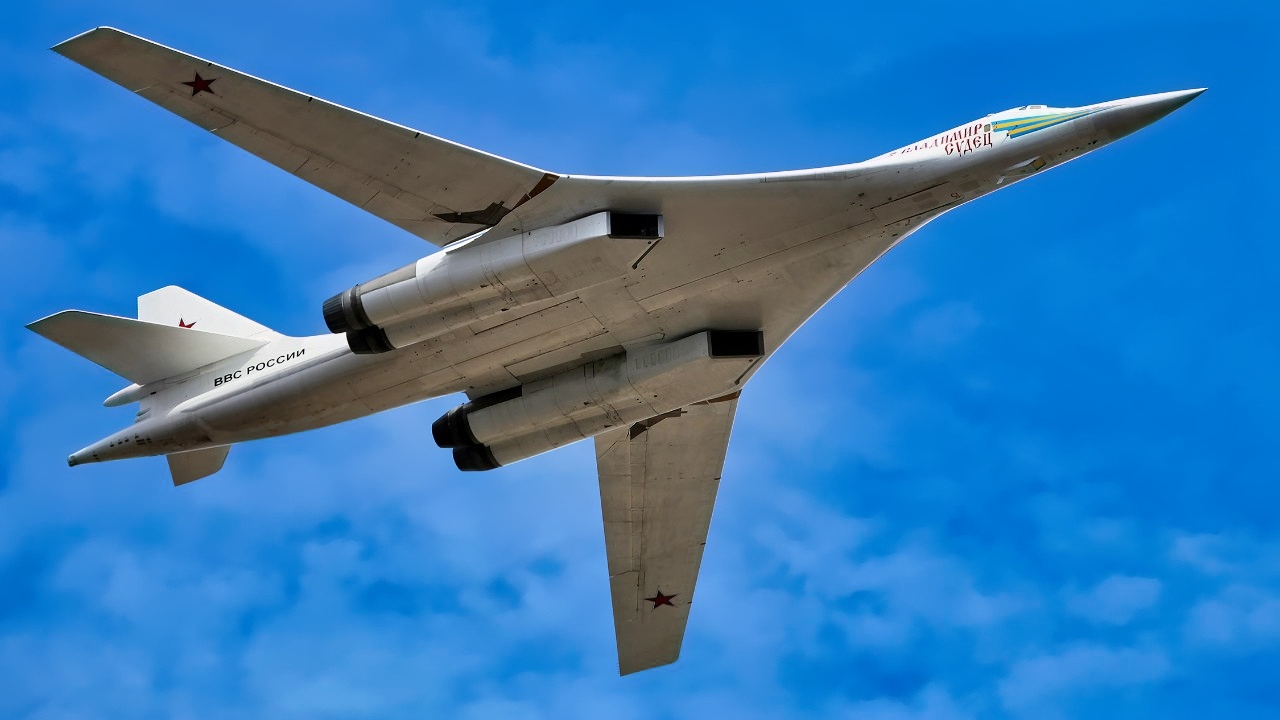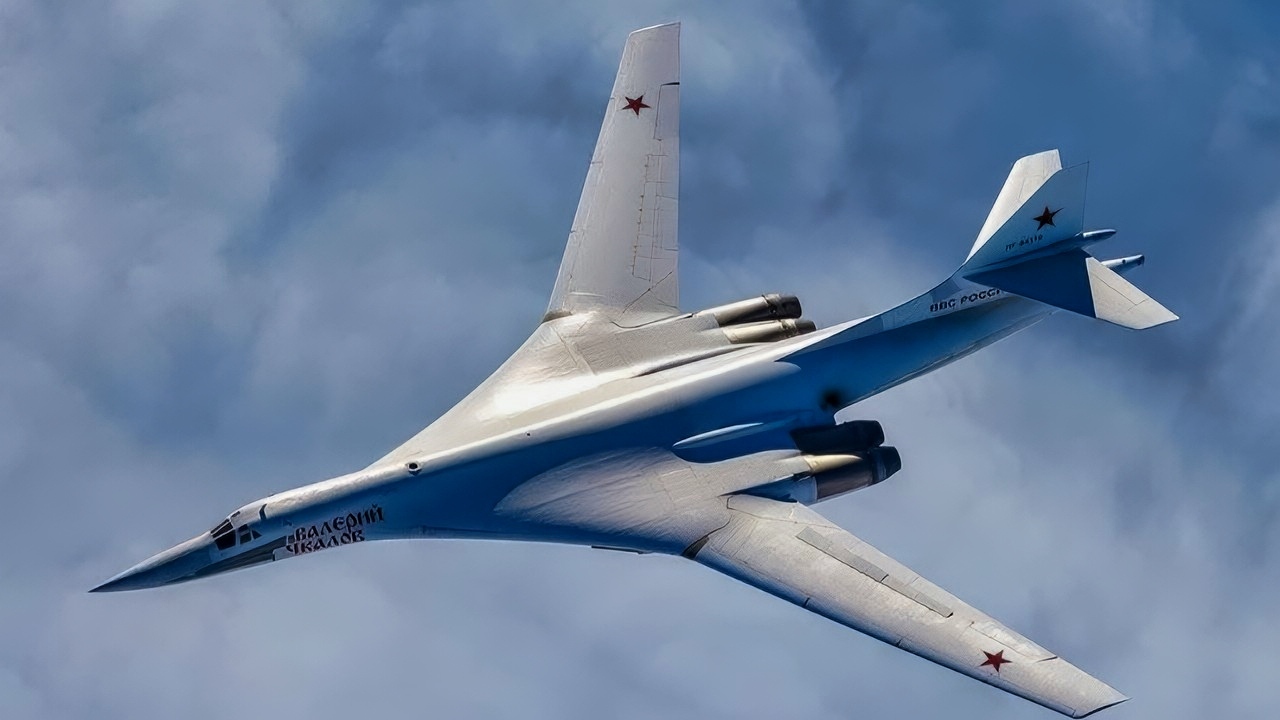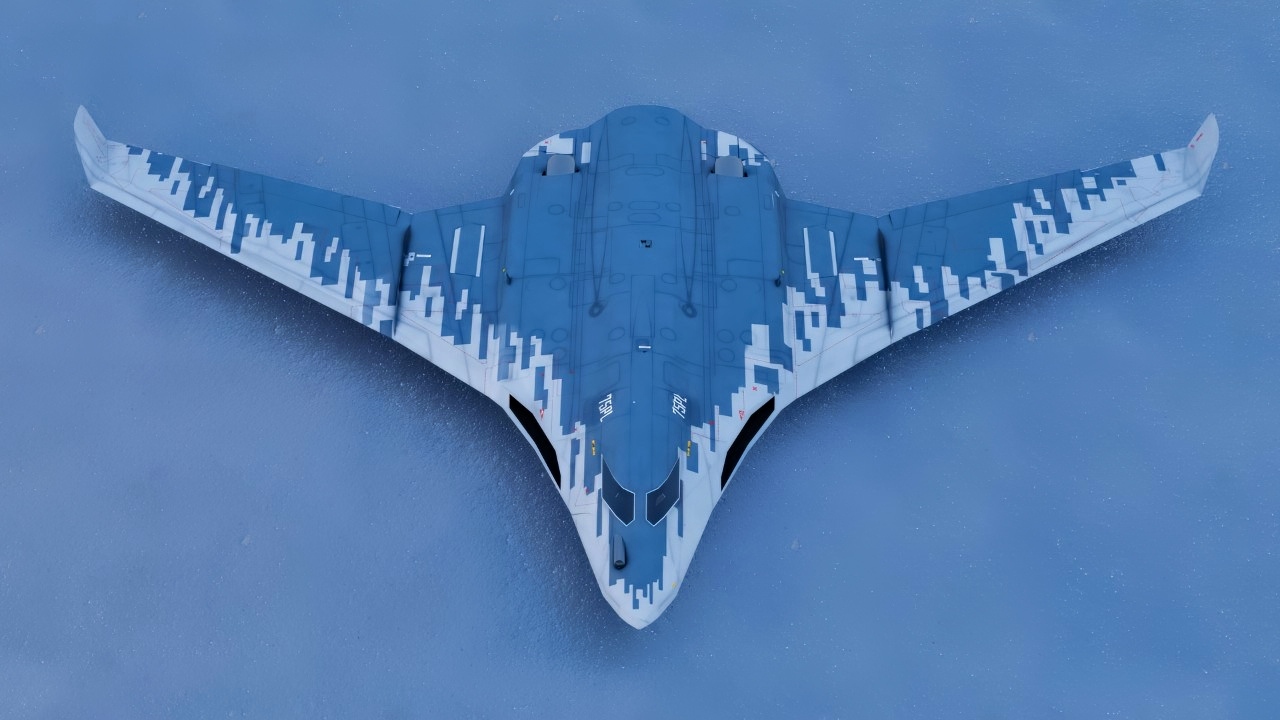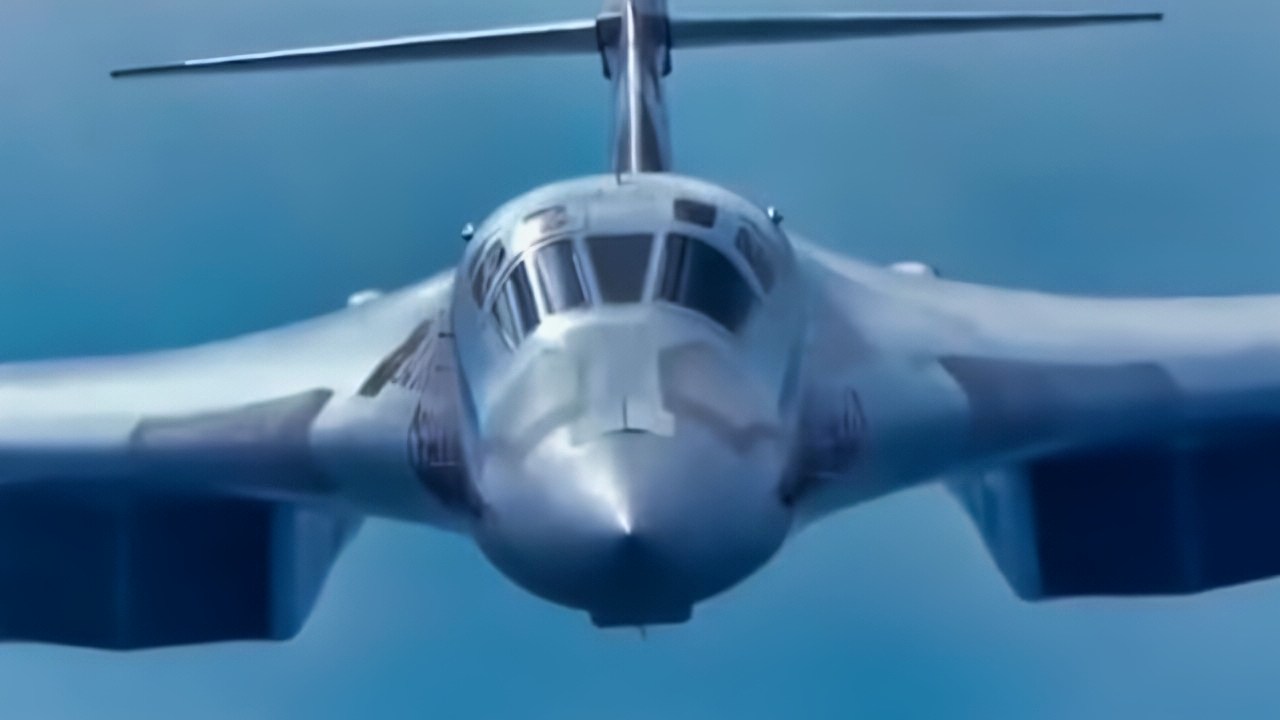Key Points and Summary – Russia’s Tu-160 “White Swan” is a Cold War giant reborn: a Mach-2, variable-sweep-wing bomber built to sling long-range cruise missiles from sanctuary.
-After post-Soviet neglect, Moscow modernized the type as the Tu-160M with new NK-32-02 engines and updated avionics, restarted limited production, and used the jet in Syria and extensively against Ukraine—launching Kh-101-class missiles from deep inside Russia.

Russian Air Force Bomber Tu-160. Image Credit: Creative Commons.
-Drone strikes on the Engels base exposed ground-side vulnerabilities, but the bomber’s stand-off role remains intact.
-With the stealthy PAK DA program delayed, the Tu-160M is Russia’s bridge to the future: a fast missile truck whose relevance depends on missile quality, availability, and base security.
Tu-160: Why Moscow Decided It Needed a Super-Fast Missile Truck
During a Track 2.0 dialogue in Manila back in 2012, I asked a Russian military officer what their best weapon of war was. He did not flinch: “Tu-160 bomber”.
That makes sense, maybe even in 2025. In the late Cold War, Soviet planners watched the U.S. Air Force pivot from the canceled B-1A to the radar-reduced B-1B and saw cruise missiles becoming the preferred way to strike from afar.
The Kremlin’s answer was not another stealth jet, but something they could field with Soviet industrial strengths: a giant, very fast, variable-sweep-wing bomber that could sprint to launch points and toss long-range missiles from well outside Western air defenses.
That concept became the Tupolev Tu-160—“White Swan” at home, “Blackjack” to NATO—a four-engine supersonic carrier for nuclear and conventional cruise missiles that also shored up the air-leg of the USSR’s nuclear triad.
Speed, range, and payload were the selling points. With four massive afterburning turbofans, internal fuel measured in the hundreds of thousands of pounds, two cavernous weapons bays, and wings that swing for takeoff, cruise, and dash, the Tu-160 was designed to blitz to a release zone, salvo missiles, and turn for home—ideally before anyone could meaningfully shoot back.
What Makes The Tu-160 Different
The Tu-160 is the world’s largest supersonic combat aircraft and the only strategic bomber that can still cruise at Mach-class speeds when required.
Its variable-geometry wings and enormous internal volume let it lift a payload in the ~40–45-ton range, carried inside two rotary-launcher bays to reduce drag.

Russian Tu-160 Bomber. Image Credit: Creative Commons.
A four-person crew sits in a pressurized forward fuselage, managing navigation, radar, electronic warfare, and the long-range missiles the aircraft was built around.
It was never meant to be a stealth aircraft; its survivability comes from staying far away and firing stand-off weapons.
Where the American B-1B traded its original emphasis on raw speed for a smaller radar signature and low-altitude penetration, the Tu-160 kept the “speed plus altitude plus range” philosophy and paired it to air-launched cruise missiles (ALCMs). In practice, that means fewer dramatic runs through dense air defenses and more launch-and-leave missions from international or Russian airspace.
From Soviet Flagship To Post-Soviet Orphan—And Back Again
The bomber entered service in the late 1980s—just in time to be upended by history. After the Soviet Union collapsed, airframes were split between Russia and newly independent Ukraine; some were later scrapped under arms-control arrangements while a subset returned to Russia via debt-settlement deals. Through the 1990s, budget starvation grounded much of Russia’s long-range aviation. Regular strategic patrols only resumed in the mid-2000s, when the Kremlin began funding a broader military revival.
A turning point came in the mid-2010s: Russia modernized part of the fleet and restarted work at Kazan to “reproduce” Tu-160s using stored airframes and updated manufacturing processes. That modernization—labeled Tu-160M—touched nearly every system onboard. Most visibly, it brought back into production the NK-32-02 engine, a refreshed version of the bomber’s immense powerplant aimed at improving range and reliability.

Tu-160 Bomber Russian Air Force. Image Credit: Russian State Media.
Avionics, navigation, communications, and defensive suites were reworked, with a digitized cockpit and new mission systems. In early 2022, a newly built Tu-160M performed its first flight, signaling that production—albeit at modest cadence—had truly restarted.
The Weapons That Give It Reach
The Tu-160’s punch is its missile menu. Historically, that meant the Kh-55/Kh-555 family; more recently, the Kh-101 (and its nuclear sibling, Kh-102) has become the signature round.
These are long-range, terrain-hugging cruise missiles designed to be launched from hundreds or even thousands of kilometers away. Russian industry has also hinted at extended-range derivatives to push launch envelopes still farther. The bomber’s bays take rotary launchers, typically twelve missiles total, though configurations vary by mission.
Because the airplane’s survival concept depends on distance, improvements to missile range, accuracy, and seeker resilience matter as much as airframe tweaks. In other words, while the Tu-160 gets the headlines, the cruise missiles it carries are the true “product” being delivered downrange.
Tu-160 Combat Debut Over Syria
The Tu-160’s combat debut came in November 2015, when Russia expanded its Syria intervention. Long-range bombers—including Tu-160s—launched air-launched cruise missiles from Russian airspace toward Islamic State and other targets in Syria.
For Moscow, those strikes were about more than battlefield effects; they advertised a modernized long-range precision-strike portfolio and provided a live-fire test of the Kh-101 family under international scrutiny. The optics were clear: Russia could hit from home.

Tu-160 Bomber from Russia. Image Credit: Creative Commons
Wartime Use Against Ukraine
Since 2022, Tu-160s have been used repeatedly to fire cruise missiles into Ukraine from deep inside Russian airspace or from over bodies of water such as the Caspian Sea.
The bomber’s range lets crews avoid Ukrainian air defenses, but not every vulnerability can be kept at arm’s length. Engels-2—the main base for Russia’s Tu-160 force—has been struck multiple times by Ukrainian long-range drones, causing fires, secondary explosions, and damage across the complex.
Those attacks underscored two realities: Ukraine has grown adept at deep strikes, and Russia’s most prized aviation assets are at risk on the ground even when they’re kept well back from the front.
In response, Russian bomber operations have adjusted launch routes and dispersal patterns, which adds flight-time and complicates logistics. The bottom line is unchanged: the Tu-160 gives Russia a persistent, if imperfect, ability to deliver stand-off munitions while staying outside the densest air-defense zones.
Engineering Reset: The Tu-160M And The Engine Story
Re-starting NK-32 engine production (in updated NK-32-02 form) has been central to the Tu-160M program. Re-tooling a legacy heavy engine line is not trivial; factories had to be modernized, suppliers refitted, and specialist skills rebuilt. The payoff is better fuel efficiency and restored engine throughput for overhauls—key for an airframe that gulps kerosene at high rates when it sprints.

Tu-160 Bomber from Russia. Image Credit: Creative Commons.
Avionics updates are equally consequential. A “glass” cockpit, new navigation and comms, updated radar, and a modernized electronic-warfare/defensive suite collectively reduce crew workload and improve survivability. There are also reports of tail-sector sensors to cue defensive systems, an admission that in the age of small drones and long-range missiles, what’s behind you matters too.
Still, the modernization cadence remains limited. Russian leaders have touted delivery milestones, but open-source evidence points to a modest flow of refurbished jets and very slow “new-build” reproduction. That’s not surprising: resurrecting 1980s tooling for one of the most complex aircraft Russia has ever built, amid sanctions and wartime supply stresses, is a tall order.
Why The Tu-160 Still Matters (Even If It Isn’t Stealth)
If you imagine strategic airpower as a portfolio, the Tu-160 covers the “long-range missile truck” slot. It is not a radar-evader that tiptoes into sophisticated defenses; it’s the platform that keeps missile salvos flowing from sanctuary. That’s valuable in three ways:
Deterrence signaling. Strategic bomber sorties—especially conspicuous ones to far-flung regions—are a diplomatic language of their own.
Stand-off strike mass. When paired with adequate missile stocks, a Tu-160 unit can deliver heavy salvos repeatedly.

Tu-160 Bomber from Russia. Image Credit: Creative Commons.
Bridging to the future. While Russia works (slowly) on a next-generation bomber, a rejuvenated Tu-160 force keeps the long-range air-strike competency alive.
Its weaknesses track the era that birthed it. The aircraft is big, not stealthy, and lives or dies by the quality and quantity of missiles it carries and the security of its bases. In contested airspace full of modern sensors and long-reach interceptors, the Tu-160 should be nowhere near the front. From far away, though, it still matters.
A Program Pulled Between Two Futures: Tu-160M Versus PAK DA
On paper, Russia’s future lies with a new stealthy flying wing bomber (often referred to as PAK DA).
In practice, timelines have slipped more than once, and open reporting suggests any prototype flight, let alone serial production, is years off. That leaves the Tu-160M as the only practical way to keep the strategic bomber force credible in the 2020s and early 2030s. The Kremlin has therefore funneled money into engine production lines, avionics upgrades, and the painstaking “reproduction” of airframes using Soviet-era structures combined with today’s manufacturing.
There’s a strategic trade here. Every ruble for Tu-160M is a ruble not available for PAK DA acceleration. But given sanctions, industrial bottlenecks, and the press of wartime demands, betting on a near-term stealth bomber miracle would be riskier than doubling down on what can fly now.

PAK DA Stealth Fighter Screenshot from X Artist Image.
The Numbers That Matter
Precise counts are murky; Russian authorities announce deliveries in broad strokes, while wartime damage assessments are contested. What’s clear is trend and role: a handful of modernized Tu-160M aircraft have been accepted in the last two years, additional airframes are in re-assembly or test, and the force continues to generate cruise-missile sorties against Ukraine. Meanwhile, repeated drone strikes have forced dispersal and base-defense upgrades and have almost certainly reduced availability at moments.
From a purely technical standpoint, the Tu-160 remains a marvel: roughly 54 meters long, wingspan over 55 meters when spread, maximum takeoff weight north of 270 tons, and a payload in the 40-plus-ton class. Top speed touches Mach 2 at altitude. None of those stats make it survivable by themselves—but they do make it a uniquely capable launcher for large salvos at long distances.
Russia’s 2015 “Demonstration” And 2022–2025 “Dependence”
The Syria strikes were a demonstration: a few dramatic salvos to showcase capability and send a message. The Ukraine war has been dependence: a grinding, months-long campaign of cruise-missile attacks on infrastructure and military targets in which Tu-160s have been one of several shooters. That shift has real consequences. It stresses airframes and crews, consumes engines and missiles, and exposes support infrastructure to counter-strikes. It also accelerates learning: every sortie pushes Russia to refine routes, tactics, and electronic-warfare approaches. As with any wartime use, the airplane gets better at what it actually does—while its vulnerabilities become more obvious to the other side.
Can A Non-Stealth Bomber Stay Relevant In A Stealth Age?
Yes—if it stays far away and if the missile is the main character.
The Tu-160’s relevance is proportional to the quality, quantity, and resilience of Russia’s ALCMs. Longer-range, more ECCM-capable missiles that can vary altitude, route, and timing make the bomber more valuable. Conversely, if sanctions or production bottlenecks limit missile output, or if defenders get very good at detecting and killing incoming ALCMs, the value equation tilts against the big, expensive launch platform that must keep flying long legs from protected airspace.
Where The Tu-160 Goes Next
Look for three lines of effort:
Industrial sustainment. Keeping NK-32-02 engines and key avionics flowing is the gating factor for fleet health.
Incremental modernization. New defensive sensors, updated EW, improved comms and navigation, and cockpit refinements will continue as parts become available.
Missile evolution. Extended-range and smarter ALCMs keep the Tu-160 viable without sending it closer to the fight.
Whether PAK DA eventually arrives in numbers is an open question. Until it does, the Tu-160M is Russia’s long-range calling card. It isn’t subtle, and it isn’t cheap to operate, but—as Syria and Ukraine both underline—it does exactly what it was built to do: move a lot of precision firepower across continents without crossing hostile borders.
The Bottom Line on the Tu-160 In Three Words: Can’t Be Retired
The Tu-160 is the rare Cold War machine that remains central to a major power’s warfighting and deterrence in 2025. It was conceived as a fast, long-range missile caddy and, after a long post-Soviet trough, has returned to that job in earnest.
Its resurrection has been slow, costly, and uneven, but the airplane’s core logic—stand-off strike at scale—still makes sense for Moscow. If the stealthy PAK DA keeps slipping, expect the “White Swan” to keep flying, modernized just enough to carry Russia’s cruise-missile strategy into the 2030s.
And that’s why retirement is not going to happen. Period.
About the Author: Harry J. Kazianis
Harry J. Kazianis (@Grecianformula) is Editor-In-Chief and President of National Security Journal. He was the former Senior Director of National Security Affairs at the Center for the National Interest (CFTNI), a foreign policy think tank founded by Richard Nixon based in Washington, DC. Harry has over a decade of experience in think tanks and national security publishing. His ideas have been published in the NY Times, The Washington Post, The Wall Street Journal, CNN, and many other outlets worldwide. He has held positions at CSIS, the Heritage Foundation, the University of Nottingham, and several other institutions related to national security research and studies. He is the former Executive Editor of the National Interest and the Diplomat. He holds a Master’s degree focusing on international affairs from Harvard University.
More Military
The U.S. Air Force’s B-52 Bomber and F-35 Fighter Have A Message for Venezuela
Russia’s Mach 4.3 MiG-41 Stealth Fighter Has a Message for the U.S. Air Force
Forget the F-35: The MQ-25 Stingray Might Be the Navy’s Best ‘Weapon’ Against China
Forget the F-35 of F-47: The GCAP 6th Generation Stealth Fighter Is Coming
U.S. and 9 Allies Just Held a Big Naval Exercise Right on China’s Doorstep










